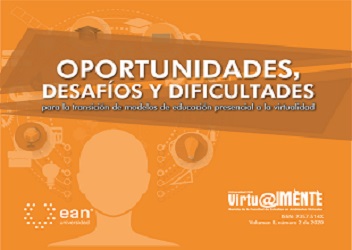Las brechas digitales en Dabeiba y Frontino, Colombia: un desafío para la educación virtual para la paz
The digital gaps in Dabeiba and Frontino, Colombia: a challenge for virtual peace education
Contenido principal del artículo
Resumen
Este es un estudio de casos centrado en la incorporación y apropiación de las Tecnologías de la Información y la Comunicación (TIC) para la educación en la ruralidad colombiana. Desde la implementación del proyecto PAZRED y su objetivo de construir una cultura de paz desde una apuesta virtual y pedagógica, se han identificado diferentes dimensiones de las brechas digitales en los municipios de Dabeiba y Frontino, en el Occidente antioqueño. Estas dimensiones se encuentran relacionadas con el acceso y uso de las tecnologías, el acompañamiento en los procesos de aprendizaje y la incorporación de la multiculturalidad de la población indígena. Este artículo expone el estado actual de las brechas digitales en estas dos zonas, así como los desafíos que presenta la educación virtual en estos escenarios. La metodología implementada en el proceso fue de carácter cualitativo, principalmente a través de entrevistas semiestructuradas, observación sistemática y revisión documental. De esta manera, se pudo dar cuenta de las brechas digitales en las zonas de estudio en términos de acceso, calidad y complejidad que se demanda para la educación en contextos con amplia diversidad cultural y de carácter rural. El análisis concluye que es necesario ampliar el concepto de «cobertura tecnológica», puesto que la apropiación tecnológica por parte de las comunidades rurales e indígenas debe ir más allá de la incorporación de TIC. Se requiere generar contenidos propios, modelos educativos y comunicativos con soporte tecnológico posicionados ética y políticamente, que reflejen las necesidades de aprendizaje, comprendan las lógicas y lenguajes propios de las comunidades.
Detalles del artículo
Referencias (VER)
Cabero-Almenara, J.; Ruiz-Palmero, J. (2017). Las Tecnologías de la Información y Comunicación para la inclusión: reformulando la brecha digital. International Journal of Educational Research and Innovation,(9), 16-30.
Cadavid-Bringe, A; Herrera-Huérfano, E.; Fayad-Sanz, D.; Vega-Casanova, J. (2017). Apropiación de TIC, pueblos indígenas de resistencia en Colombia: el caso del Tejido de Comunicación. En F. Sierra Caballero; T. Gravante (Coord.), Tecnopolítica en América Latina y el Caribe. (145-169). Salamanca: Comunicación Social Ediciones y Publicaciones.
Departamento Administrativo Nacional de Estadística (DANE). (2018). Censo Nacional de Población y Vivienda 2018 Colombia. Recuperado de https://bit.ly/3fgGv2k
DANE. (2020). Proyección de poblaciones. Recuperado de https://bit.ly/3kQdw6S Ministerio de Educación Nacional (MEN). (2019). Plan Estratégico Institucional 2019-2022 Recuperado de https://bit.ly/38ZGCya
Ministerio de Tecnologías de la Información y Comunicaciones (MinTIC). (2018a). Plan TIC 2018 – 2022 El Futuro Digital es de Todos. Recuperado de https://bit.ly/2UHUmW4
MinTIC. (2018b). Plan Nacional de Conectividad Rural. Recuperado de https://bit.ly/2UIggIT
Unesco. (5-9 de octubre de 1998). World Conference on Higher Education. Higher Education in the Twenty-First Century: Vision and Action. París, Francia. Recuperado de https://bit.ly/3fjnMmQ
Villatoro, S.; Silva, A. (2005). Estrategias, programas y experiencias de superación de la brecha digital y universalización del acceso a las nuevas tecnologías de información ycomunicación (TIC). Un panorama regional. Santiago de Chile: Cepal. Recuperado de https://bit.ly/3pJvxY6
Wikimedia Commons (2010). Mapa del Municipio de Dabeiba, Antioquia (Colombia). Recuperado de https://bit.ly/35McHrq
Datos de publicación
Declaraciones de autoría
Indexado en
- Sociedad académica
- Universidad Ean
- Editorial
- Universidad Ean









